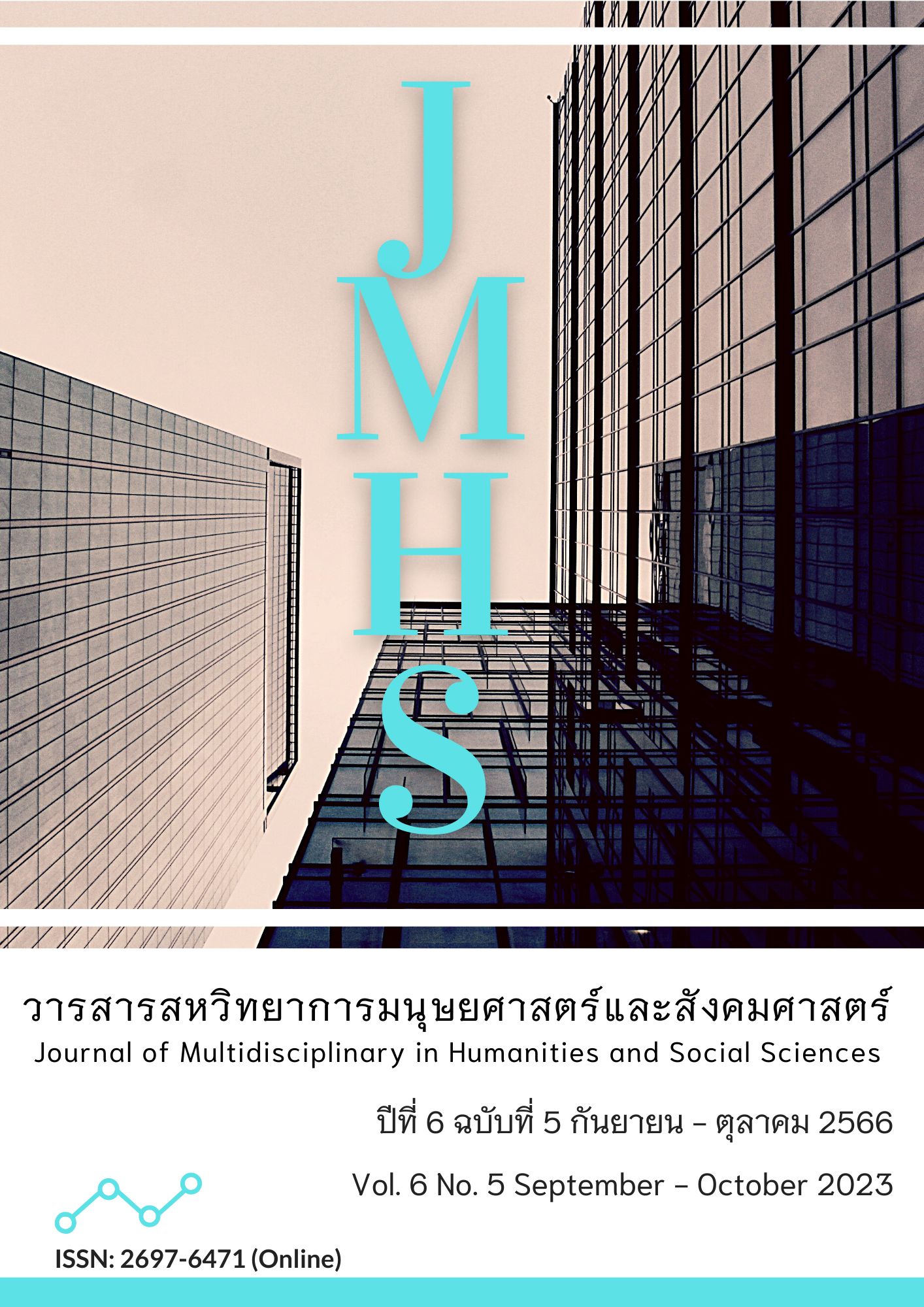Developing Learning Activities by Using Context-Based Learning with Infographics to Enhance Chemical Literacy on the Topic of Polymer of Grade 12 Students
Main Article Content
Abstract
The purposes of this study were (1) to investigate ways of using Context-Based Learning with infographics for enhancing Chemical Literacy and (2) to examine the result of the developed learning management for enhancing Chemical Literacy on the topic of Polymer. This research was classroom action research model. The participants were 38 12th-grade students. They were selected by purposive sampling. The research instruments were: the developed lesson plans, reflect journal, the chemical literacy test and the students’ activities worksheets. Analysis data by content analysis and data creditability by triangulation was used.
The results found that 1. Using Context-Based Learning with Infographics to enhance chemical literacy involves the following processes: First, the teacher presents contexts that are relevant to students' lives to motivate their learning skills. Second, students plan and search for information from the students' activities worksheets. Third, students analyze and select reliable and correct information while giving proper reasons. Then, students use the information to make infographics and present their work. After that, the teacher and students summarize the knowledge. Next, the teacher presents new contexts that are similar to the previous contexts to show that this concept can be used in different contexts. The final step is for students to summarize the knowledge and how it can be used in their everyday lives by making infographics. 2. The results found that most of students had a high level of chemical literacy after learning through Context-Based Learning with infographics.
Article Details

This work is licensed under a Creative Commons Attribution-NonCommercial-NoDerivatives 4.0 International License.
Views and opinions appearing in the Journal it is the responsibility of the author of the article, and does not constitute the view and responsibility of the editorial team.
References
จงรัก เทศนา. (ม.ป.ป.). อินโฟกราฟิกส์ (Infographics). สืบค้นเมื่อ 27 สิงหาคม 2565, จาก https://chachoengsao.cdd.go.th/wp-content/uploads/sites/9/2019/01/infographics_information.pdf
นพดล พรามณี. (2560). การออกแบบและการประยุกต์ใช้สื่ออินโฟกราฟิกในปัจจุบัน. วารสารเทคโนโลยีภาคใต้, 10(1), 159-168.
ปวันรัตน์ ศรีพรหม และ อังคนา อ่อนธานี. (2562). การพัฒนากิจกรรมการเรียนรู้โดยใช้บริบทเป็นฐานร่วมกับอินโฟกราฟิกเพื่อส่งเสริมการรู้ เรื่อง วิทยาศาสตร์และเจตคติต่อวิทยาศาสตร์ เรื่องพันธะเคมี สำหรับนักเรียนชั้นมัธยมศึกษาปีที่ 4. วารสารศึกษาศาสตร์ มหาวิทยาลัยนเรศวร, 23(3), 159-174.
พัชรา วาณิชวศิน. (2558). ศักยภาพของอินโฟกราฟิก (Infographic) ในการเพิ่มคุณภาพการเรียนรู้. วารสารปัญญาภิวัฒน์, 7(พิเศษ), 227-240.
พลอยนัดดา ผาบไชย และ สุรีย์พร สว่างเมฆ. (2561). การพัฒนาการรู้วิทยาศาสตร์ เรื่อง กรด-เบส ด้วยการจัดการเรียนรู้ที่ใช้บริบทเป็นฐาน สำหรับนักเรียนชั้นมัธยมศึกษาปีที่ 5. วารสารศึกษาศาสตร์ มหาวิทยาลัยนเรศวร, 22(3), 164-176.
สถาบันส่งเสริมการสอนวิทยาศาสตร์และเทคโนโลยี (สสวท.). (2559). สรุปผลการประเมิน PISA 2015. สืบค้นเมื่อ 17 กรกฎาคม 2565, จาก https://pisathailand.ipst.ac.th/pisa2015summary
สถาบันส่งเสริมการสอนวิทยาศาสตร์และเทคโนโลยี (สสวท.). (2561). ผลการประเมิน PISA 2015 วิทยาศาสตร์ การอ่าน และคณิตศาสตร์ ความเป็นเลิศและความเท่าเทียมทางการศึกษา. กรุงเทพฯ: ซัคเซสพับลิเคชั่น.
สถาบันส่งเสริมการสอนวิทยาศาสตร์และเทคโนโลยี (สสวท.). (2564). ผลการประเมิน PISA 2018 การอ่าน คณิตศาสตร์ และวิทยาศาสตร์. กรุงเทพฯ: ซัคเซสพับลิเคชั่น.
สำนักงานเลขาธิการวุฒิสภา. (2561). เทคนิคการจัดทำและการนำเสนอข้อมูลทางวิชาการ ในรูปแบบอินโกราฟิก. สืบค้นเมื่อ 27 สิงหาคม 2565, จาก https://www.senate.go.th/assets/portals/49/news/110/2_7
American Association for the Advancement of Science (AAAS). (1993). Benchmarks for Science Literacy. Oxford: Oxford University.
Bicen, H., & Beheshti, M. (2019). Assessing perceptions and evaluating achievements of ESL students with the usage of infographics in a flipped classroom learning environment. Interactive Learning Environments, 27(7), 1-29. DOI:10.1080/10494820.2019.1666285
Cigdemoglu, C., Arslan, O.H., & Çam, A. (2017). Argumentation to foster pre-service science teachers’ knowledge, competency, and attitude on the domains of chemical literacy of acids and bases. Chemistry Education Research and Practice, 18(2). DOI:10.1039/C6RP00167J
Gilbert, J. K. (2006). On the nature of “context” in chemical education. International Journal of Science Education, 28(9), 957-976. DOI:10.1080/09500690600702470
Kemmis, S., & McTaggart, R. (1992). The Action Research Planner. (3rd ed.). Geelong: Deakin University.
OECD. (2017). PISA 2015 Assessment and Analytical Framework: Science, Reading, Mathermatic, Financial Literacy and Collaborative Problem Solving. Paris: OECD.
OECD. (2017). PISA 2015 Result in Focus. Retrieved July 17, 2022, from https://www.oecd.org/pisa/pisa-2015-results-in-focus.pdf
OECD. (2019). PISA 2018 Insights and Interpretations. Retrieved July 17, 2022, from https://www.oecd.org/pisa/PISA%202018%20Insights%20and%20Interpretations%20FINAL%20PDF.pdf
Shwartz, Y., Ben-Zvi, R., & Hofstein, A. (2006). Chemical literacy: What does this mean to scientists and school teachers? Journal of Chemical Education, 83(10). DOI: 10.1021/ed083p1557
Shwartz, Y., Ben-Zvi, R., & Hofstein, A. (2006). The use of scientific literacy taxonomy for assessing the development of chemical literacy among high school students. Chemistry Education Research and Practice, 7(4), 203-225. DOI:10.1039/B6RP90011A
Williams, C. (2007). Transfer in Context: Replication and Adaptation in Knowledge Transfer Relationships. Strategic Management Journal, 28(9), 867–889. http://www.jstor.org/stable/20141955


